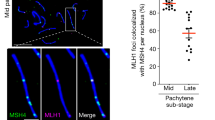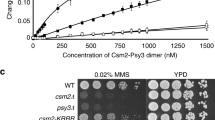Abstract
The ubiquitously expressed Rad51 recombinase and the meiosis-specific Dmc1 recombinase promote the formation of strand-invasion products (D-loops) between homologous molecules. Strand-invasion products are processed by either the double-strand break repair (DSBR) or synthesis-dependent strand annealing (SDSA) pathway. D-loops destined to be processed by SDSA need to dissociate, producing non-crossovers, and those destined for DSBR should resist dissociation to generate crossovers. The mechanism that channels recombination intermediates into different homologous-recombination pathways is unknown. Here we show that D-loops in a human DMC1-driven reaction are substantially more resistant to dissociation by branch-migration proteins such as RAD54 than those formed by RAD51. We propose that the intrinsic resistance to dissociation of DMC1 strand-invasion intermediates may account for why DMC1 is essential to ensure the proper segregation of chromosomes in meiosis.
This is a preview of subscription content, access via your institution
Access options
Subscribe to this journal
Receive 12 print issues and online access
$189.00 per year
only $15.75 per issue
Buy this article
- Purchase on Springer Link
- Instant access to full article PDF
Prices may be subject to local taxes which are calculated during checkout



Similar content being viewed by others
Change history
09 August 2011
In the version of this article initially published, the legend for Figure 2d,e did not include the source of the data in those panels. These data originally appeared in ref. 20. The error has been corrected in the HTML and PDF versions of the article.
10 October 2012
In the version of this article initially published, support from the Oklahoma Center for the Advancement of Science and Technology to R.J.P. was not acknowledged. The error has been corrected in the PDF and HTML versions of this article.
References
Haber, J.E. DNA recombination: the replication connection. Trends Biochem. Sci. 24, 271–275 (1999).
Johnson, R.D. & Jasin, M. Double-strand-break-induced homologous recombination in mammalian cells. Biochem. Soc. Trans. 29, 196–201 (2001).
Pâques, F. & Haber, J.E. Multiple pathways of recombination induced by double-strand breaks in Saccharomyces cerevisiae. Microbiol. Mol. Biol. Rev. 63, 349–404 (1999).
Whitby, M.C. Making crossovers during meiosis. Biochem. Soc. Trans. 33, 1451–1455 (2005).
Petronczki, M., Siomos, M.F. & Nasmyth, K. Un menage a quatre: the molecular biology of chromosome segregation in meiosis. Cell 112, 423–440 (2003).
Krogh, B.O. & Symington, L.S. Recombination proteins in yeast. Annu. Rev. Genet. 38, 233–271 (2004).
Neale, M.J. & Keeney, S. Clarifying the mechanics of DNA strand exchange in meiotic recombination. Nature 442, 153–158 (2006).
Mimitou, E.P. & Symington, L.S. Sae2, Exo1 and Sgs1 collaborate in DNA double-strand break processing. Nature 455, 770–774 (2008).
Zhu, Z., Chung, W.H., Shim, E.Y., Lee, S.E. & Ira, G. Sgs1 helicase and two nucleases Dna2 and Exo1 resect DNA double-strand break ends. Cell 134, 981–994 (2008).
Gravel, S., Chapman, J.R., Magill, C. & Jackson, S.P. DNA helicases Sgs1 and BLM promote DNA double-strand break resection. Genes Dev. 22, 2767–2772 (2008).
Bianco, P.R., Tracy, R.B. & Kowalczykowski, S.C. DNA strand exchange proteins: a biochemical and physical comparison. Front. Biosci. 3, D570–D603 (1998).
Sung, P., Krejci, L., Van Komen, S. & Sehorn, M.G. Rad51 recombinase and recombination mediators. J. Biol. Chem. 278, 42729–42732 (2003).
Allers, T. & Lichten, M. Differential timing and control of noncrossover and crossover recombination during meiosis. Cell 106, 47–57 (2001).
Jessop, L., Rockmill, B., Roeder, G.S. & Lichten, M. Meiotic chromosome synapsis-promoting proteins antagonize the anti-crossover activity of sgs1. PLoS Genet. 2, e155 (2006).
Hunter, N. & Kleckner, N. The single-end invasion: an asymmetric intermediate at the double-strand break to double-holliday junction transition of meiotic recombination. Cell 106, 59–70 (2001).
Börner, G.V., Kleckner, N. & Hunter, N. Crossover/noncrossover differentiation, synaptonemal complex formation, and regulatory surveillance at the leptotene/zygotene transition of meiosis. Cell 117, 29–45 (2004).
Szostak, J.W., Orr-Weaver, T.L., Rothstein, R.J. & Stahl, F.W. The double-strand break repair model for recombination. Cell 33, 25–35 (1983).
Schwacha, A. & Kleckner, N. Identification of double Holliday junctions as intermediates in meiotic recombination. Cell 83, 783–791 (1995).
Nassif, N., Penney, J., Pal, S., Engels, W.R. & Gloor, G.B. Efficient copying of nonhomologous sequences from ectopic sites via P-element-induced gap repair. Mol. Cell. Biol. 14, 1613–1625 (1994).
Bugreev, D.V., Hanaoka, F. & Mazin, A.V. Rad54 dissociates homologous recombination intermediates by branch migration. Nat. Struct. Mol. Biol. 14, 746–753 (2007).
Masson, J.Y. & West, S.C. The Rad51 and Dmc1 recombinases: a non-identical twin relationship. Trends Biochem. Sci. 26, 131–136 (2001).
Bishop, D.K., Park, D., Xu, L. & Kleckner, N. DMC1: a meiosis-specific yeast homolog of E. coli recA required for recombination, synaptonemal complex formation, and cell cycle progression. Cell 69, 439–456 (1992).
Schwacha, A. & Kleckner, N. Interhomolog bias during meiotic recombination: meiotic functions promote a highly differentiated interhomolog-only pathway. Cell 90, 1123–1135 (1997).
Lim, D.S. & Hasty, P. A mutation in mouse rad51 results in an early embryonic lethal that is suppressed by a mutation in p53. Mol. Cell. Biol. 16, 7133–7143 (1996).
Pittman, D.L. et al. Meiotic prophase arrest with failure of chromosome synapsis in mice deficient for Dmc1, a germline-specific RecA homolog. Mol. Cell 1, 697–705 (1998).
Bannister, L.A. et al. A dominant, recombination-defective allele of Dmc1 causing male-specific sterility. PLoS Biol. 5, e105 (2007).
Sung, P. Catalysis of ATP-dependent homologous DNA pairing and strand exchange by yeast RAD51 protein. Science 265, 1241–1243 (1994).
Sehorn, M.G., Sigurdsson, S., Bussen, W., Unger, V.M. & Sung, P. Human meiotic recombinase Dmc1 promotes ATP-dependent homologous DNA strand exchange. Nature 429, 433–437 (2004).
Symington, L.S. & Heyer, W.D. Some disassembly required: role of DNA translocases in the disruption of recombination intermediates and dead-end complexes. Genes Dev. 20, 2479–2486 (2006).
van Brabant, A.J. et al. Binding and melting of D-loops by the Bloom syndrome helicase. Biochemistry 39, 14617–14625 (2000).
Bachrati, C.Z., Borts, R.H. & Hickson, I.D. Mobile D-loops are a preferred substrate for the Bloom′s syndrome helicase. Nucleic Acids Res. 34, 2269–2279 (2006).
Bugreev, D.V., Yu, X., Egelman, E.H. & Mazin, A.V. Novel pro- and anti-recombination activities of the Bloom′s syndrome helicase. Genes Dev. 21, 3085–3094 (2007).
Bugreev, D.V., Mazina, O.M. & Mazin, A.V. Rad54 protein promotes branch migration of Holliday junctions. Nature 442, 590–593 (2006).
Karow, J.K., Constantinou, A., Li, J.L., West, S.C. & Hickson, I.D. The Bloom′s syndrome gene product promotes branch migration of holliday junctions. Proc. Natl. Acad. Sci. USA 97, 6504–6508 (2000).
McVey, M., Larocque, J.R., Adams, M.D. & Sekelsky, J.J. Formation of deletions during double-strand break repair in Drosophila DmBlm mutants occurs after strand invasion. Proc. Natl. Acad. Sci. USA 101, 15694–15699 (2004).
Ira, G., Malkova, A., Liberi, G., Foiani, M. & Haber, J.E. Srs2 and Sgs1-Top3 suppress crossovers during double-strand break repair in yeast. Cell 115, 401–411 (2003).
Prakash, R. et al. Yeast Mph1 helicase dissociates Rad51-made D-loops: implications for crossover control in mitotic recombination. Genes Dev. 23, 67–79 (2009).
Oh, S.D. et al. BLM ortholog, Sgs1, prevents aberrant crossing-over by suppressing formation of multichromatid joint molecules. Cell 130, 259–272 (2007).
Moynahan, M.E. & Jasin, M. Loss of heterozygosity induced by a chromosomal double-strand break. Proc. Natl. Acad. Sci. USA 94, 8988–8993 (1997).
Lasko, D., Cavenee, W. & Nordenskjold, M. Loss of constitutional heterozygosity in human cancer. Annu. Rev. Genet. 25, 281–314 (1991).
Bugreev, D.V. & Mazin, A.V. Ca2+ activates human homologous recombination protein Rad51 by modulating its ATPase activity. Proc. Natl. Acad. Sci. USA 101, 9988–9993 (2004).
Bugreev, D.V., Golub, E.I., Stasiak, A.Z., Stasiak, A. & Mazin, A.V. Activation of human meiosis-specific recombinase Dmc1 by Ca2+. J. Biol. Chem. 280, 26886–26895 (2005).
Petukhova, G.V. et al. The Hop2 and Mnd1 proteins act in concert with Rad51 and Dmc1 in meiotic recombination. Nat. Struct. Mol. Biol. 12, 449–453 (2005).
Pezza, R.J., Petukhova, G.V., Ghirlando, R. & Camerini-Otero, R.D. Molecular activities of meiosis-specific proteins Hop2, Mnd1, and the Hop2-Mnd1 complex. J. Biol. Chem. 281, 18426–18434 (2006).
Chi, P., San Filippo, J., Sehorn, M.G., Petukhova, G.V. & Sung, P. Bipartite stimulatory action of the Hop2-Mnd1 complex on the Rad51 recombinase. Genes Dev. 21, 1747–1757 (2007).
Pezza, R.J., Voloshin, O.N., Vanevski, F. & Camerini-Otero, R.D. Hop2/Mnd1 acts on two critical steps in Dmc1-promoted homologous pairing. Genes Dev. 21, 1758–1766 (2007).
Hsieh, P. & Camerini-Otero, C.S. & Camerini-Otero, R.D. The synapsis event in the homologous pairing of DNAs: RecA recognizes and pairs less than one helical repeat of DNA. Proc. Natl. Acad. Sci. USA 89, 6492–6496 (1992).
Voloshin, O.N., Wang, L. & Camerini-Otero, R.D. Homologous DNA pairing promoted by a 20-amino acid peptide derived from RecA. Science 272, 868–872 (1996).
Voloshin, O.N. & Camerini-Otero, R.D. The duplex DNA is very underwound in the three-stranded RecA protein-mediated synaptic complex. Genes Cells 2, 303–314 (1997).
Busygina, V. et al. Hed1 regulates Rad51-mediated recombination via a novel mechanism. Genes Dev. 22, 786–795 (2008).
Shinohara, M., Sakai, K., Shinohara, A. & Bishop, D.K. Crossover interference in Saccharomyces cerevisiae requires a TID1/RDH54- and DMC1-dependent pathway. Genetics 163, 1273–1286 (2003).
Hayase, A. et al. A protein complex containing Mei5 and Sae3 promotes the assembly of the meiosis-specific RecA homolog Dmc1. Cell 119, 927–940 (2004).
Chi, P. et al. Functional interactions of meiotic recombination factors Rdh54 and Dmc1. DNA Repair (Amst.) 8, 279–284 (2009).
Petukhova, G., Sung, P. & Klein, H. Promotion of Rad51-dependent D-loop formation by yeast recombination factor Rdh54/Tid1. Genes Dev. 14, 2206–2215 (2000).
Okorokov, A.L. et al. Structure of the hDmc1-ssDNA filament reveals the principles of its architecture. PLoS ONE 5, e8586 (2010).
Ramesh, M.A., Malik, S.B. & Logsdon, J.M. Jr. A phylogenomic inventory of meiotic genes; evidence for sex in Giardia and an early eukaryotic origin of meiosis. Curr. Biol. 15, 185–191 (2005).
Dernburg, A.F. et al. Meiotic recombination in C. elegans initiates by a conserved mechanism and is dispensable for homologous chromosome synapsis. Cell 94, 387–398 (1998).
MacQueen, A.J., Colaiacovo, M.P., McDonald, K. & Villeneuve, A.M. Synapsis-dependent and -independent mechanisms stabilize homolog pairing during meiotic prophase in C. elegans. Genes Dev. 16, 2428–2442 (2002).
Vazquez, J., Belmont, A.S. & Sedat, J.W. The dynamics of homologous chromosome pairing during male Drosophila meiosis. Curr. Biol. 12, 1473–1483 (2002).
Mazina, O.M. & Mazin, A.V. Human Rad54 protein stimulates DNA strand exchange activity of hRad51 protein in the presence of Ca2+. J. Biol. Chem. 279, 52042–52051 (2004).
Acknowledgements
We thank P. Sung (Yale University) and W. Holloman (Cornell University) for RAD51 and BLM expression vectors, members of the Camerini-Otero and Mazin labs for comments and discussion, and M. Lichten and P. Hsieh for critical reading of this manuscript. This work was supported by US National Institutes of Health grants CA100839 and MH084119, the Leukemia and Lymphoma Society Scholar Award 1054-09 (to A.V.M.), the Oklahoma Center for the Advancement of Science and Technology Project HR10-048S (to R.J.P.) and the Intramural Research Program of the US National Institute of Diabetes and Digestive and Kidney Diseases (to R.D.C.-O.).
Author information
Authors and Affiliations
Contributions
D.V.B., R.J.P., A.V.M. and R.D.C.-O. conceived the general ideas for this study. All authors planned experiments and interpreted data. D.V.B., R.J.P., O.N.V. and O.M.M. performed experiments. A.V.M. and R.D.C.-O. wrote the manuscript, and all authors provided editorial input.
Corresponding authors
Ethics declarations
Competing interests
The authors declare no competing financial interests.
Supplementary information
Supplementary Text and Figures
Supplementary Methods, Supplementary Figures 1–5 and Supplementary Table 1 (PDF 2614 kb)
Rights and permissions
About this article
Cite this article
Bugreev, D., Pezza, R., Mazina, O. et al. The resistance of DMC1 D-loops to dissociation may account for the DMC1 requirement in meiosis. Nat Struct Mol Biol 18, 56–60 (2011). https://doi.org/10.1038/nsmb.1946
Received:
Accepted:
Published:
Issue Date:
DOI: https://doi.org/10.1038/nsmb.1946
This article is cited by
-
A novel recombination protein C12ORF40/REDIC1 is required for meiotic crossover formation
Cell Discovery (2023)
-
FIGNL1 AAA+ ATPase remodels RAD51 and DMC1 filaments in pre-meiotic DNA replication and meiotic recombination
Nature Communications (2023)
-
Repair of DNA double-strand breaks in plant meiosis: role of eukaryotic RecA recombinases and their modulators
Plant Reproduction (2023)
-
The DNA Double-Strand Break Repair in Glioma: Molecular Players and Therapeutic Strategies
Molecular Neurobiology (2022)
-
Genomic analysis finds no evidence of canonical eukaryotic DNA processing complexes in a free-living protist
Nature Communications (2021)



